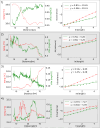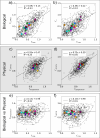Emergent patterns of patchiness differ between physical and planktonic properties in the ocean
- PMID: 39979274
- PMCID: PMC11842825
- DOI: 10.1038/s41467-025-56794-x
Emergent patterns of patchiness differ between physical and planktonic properties in the ocean
Abstract
While a rich history of patchiness research has explored spatial structure in the ocean, there is no consensus over the controls on biological patchiness and how physical-ecological-biogeochemical processes and patchiness relate. The prevailing thought is that physics structures biology, but this has not been tested at basin scale with consistent in situ measurements. Here we use the slope of the relationship between variance vs spatial scale to quantify patchiness and ~650,000 nearly continuous (dx ~ 200 m) measurements - representing the Atlantic, Pacific, and Southern Oceans - and find that patchiness of biological parameters and physical parameters are uncorrelated. We show variance slope is an emergent property with unique patterns in biogeochemical properties distinct from physical tracers, yet correlated with other biological tracers. These results provide context for decades of observations with different interpretations, suggest the use of spatial tests of biogeochemical model parameterizations, and open the way for studies into processes regulating the observed patterns.
© 2025. The Author(s).
Conflict of interest statement
Competing interests: The authors declare no competing interests.
Figures








References
-
- Laws, E. A. Evaluation of in situ phytoplankton growth rates: a synthesis of data from varied approaches. Ann. Rev. Mar. Sci.5, 247–268 (2013). - PubMed
-
- Falkowski, P. G., Barber, R. T. & Smetacek, V. Biogeochemical controls and feedbacks on ocean primary production. Science (1979)281, 200–206 (1998). - PubMed
-
- Behrenfeld, M. J. & Boss, E. Resurrecting the ecological underpinnings of ocean plankton blooms. Ann. Rev. Mar. Sci.6, 167–194 (2014). - PubMed
-
- Banse, K. Grazing and zooplankton production as key controls of phytoplankton production in the open ocean. Oceanography7, 13–20 (1994).
-
- Levin, S. A. The problem of pattern and scale in ecology. Ecology73, 1943–1967 (1992).
LinkOut - more resources
Full Text Sources

